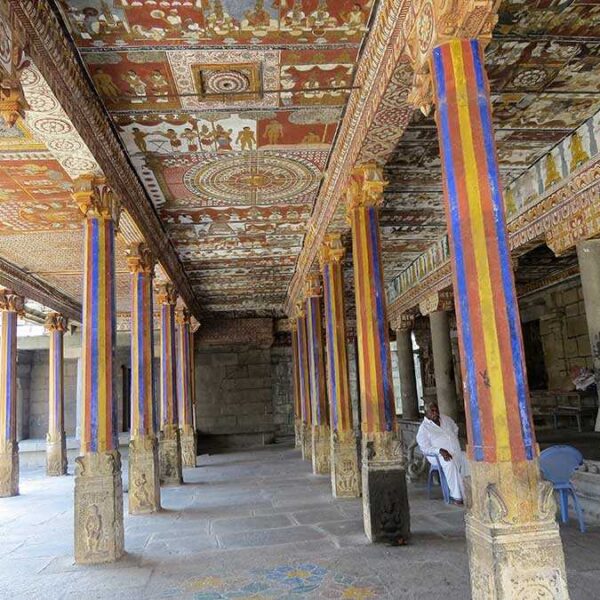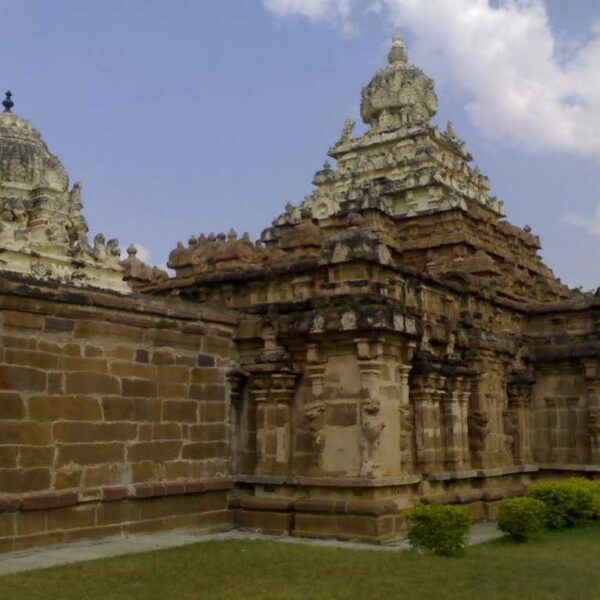Complete Guide about Kailasanathar Temple
-
Location
Kailasanathar Temple, Pillaiyarpalayam, Kanchipuram, Tamil Nadu 631501
-
Timings
Every day
5:30 AM to 12:00 PM
& 4:00 PM to 9:00 PM -
Entry Fee
No Entry fee


Kailasanathar Temple
About Kailasanathar Temple
The oldest structure in Kanchipuram, Tamil Nadu, is the Kailasanathar Temple, which was constructed between 685-705 AD under the Pallava Dynasty. The Lord Shiva is the subject of the temple. It has about 58 sub-shrines, each of which is devoted to a different manifestation of the god. The temple is decorated with half-animal gods and exquisite sculptures and paintings of Lord Shiva and Goddess Parvati. It also displays Dravidian-style architecture.
The Maha Shivaratri celebration turns the temple into a tourist destination.
At this time, Lord Shiva worshipers throng the temple complex to pay respects and make prayers.
The temple draws a sizable number of history aficionados because of its historical significance and architectural fame.
Visitors are welcome on the property from 5:30 am to 9:00 pm.
Guruvayur Temple Official website Link www.guruvayurdevaswom.in
The History
Kanchipuram, sometimes called Kanchi or Shiva Vishnu Kanchi, served as the Pallava dynasty’s capital city and the centre of their empire. Under their Emperor Narasimhavarman I, the rulers thereafter increased their domains inside the Tamil, Andhra, and Kannada realms and began constructing several temples of significant and priceless worth. The Tiru Parameswara Vinnagaram and the Kanchi Kailasanathar Temple are two temples that stand out and are noteworthy.
Literally translated as “Lord of the Cosmic Mountain,” the Kanchi Kailasanathar Temple was constructed in accordance with the Smartha tradition of worshipping Lord Shiva, Lord Vishnu, Devi, Surya, Lord Ganesha, and Kartikeya. The temple was constructed between 685 and 705 AD by Narasimhavarman I, also known as Rajasimha Pallaveswaram, and is the earliest structural temple to have been built in South India. The front façade and tower of the temple were eventually finished by his son Mahendravarman III.
The Kanchi Kailasanathar Temple became the first temple to be built of sandstone and established the standard for all subsequent temples that followed, unlike temples that were built of wood or hewn into rocks. During those periods’ battles, the vast temple served as a safe haven for the monarchs. The kings created a hidden tunnel that is still accessible as a means of escape. Currently, the Archaeological Survey of India is responsible for maintaining the Kanchi Kailasanathar Temple.
The Architecture of Temple
The Kanchi Kailasanathar Temple is an architectural masterpiece that was constructed in the traditional Dravidian style. Granite serves as the temple’s foundation. This granite base gives the foundation the ability to support the enormous, towering temple building. All of the sculptures and the outside framework are made of sandstone. In total, the temple features 58 mini shrines that are incorporated into the niches of the compound wall that surrounds the main shrine. The main temple features sculptures of Lord Shiva and Goddess Parvati doing different dancing moves.The main hall, a lofty compound wall, and an entry gate known as the gopuram are all included in the temple complex in addition to these little shrines.
On the pillars of the mandapa, lion statues stand on their hind legs as if to warn people not to destroy the temple.
The Kanchi Kailasanathar Temple’s design is straightforward, with a tower known as a “shikara” erected in the centre of the compound. This tower rises in a pyramidal shape and has a dome-shaped roof at the top. There are 16 black granite Shivalingas in the sanctum sanctorum, the main shrine. Numerous Gods and Goddesses, including Brahma, Vishnu, Nandi, Durga Maa, and Lord Shiva in the destructive dance position, are depicted on both the inner and exterior walls.Also present at the entryway is a Nandi sculpture. The temple’s west wall depicts Shiva in the form of Lingodhbav, while its south wall features a highly elegant representation of Lord Shiva in a reclining position and tranquilly known as Dakshinamurti.
Dekho Apna Desh
The DAD of Tourism
Get Direction to Kailasanathar Temple
Near Attractions







